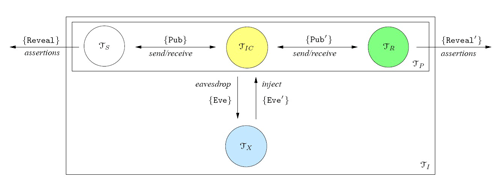
This issue in pdf Subscription Archive: Next issue: January 2006 |
|
||||
Contributions of Team Automata in Securityby Maurice ter Beek, Gabriele Lenzini, and Marinella Petrocchi Researchers from two CNR Institutes in Pisa are studying ways in which a formal model of team automata can be exploited to specify and analyse security-related issues. The Information Security group at the Institute for Informatics and Telematics (IIT-CNR) has both practical and theoretical experience with many aspects of security. The Formal Methods and Tools (FM&&T) group at the Institute of Information Science and Technologies (ISTI-CNR) has experience in research on formal methods for the specification, design and verification of computer systems. Recently, researchers from these two groups teamed up to investigate how a formal model of team automata can contribute to the specification and analysis of security issues. This cooperation will be continued in the context of an EU-funded project on Software Engineering for Service-Oriented Overlay Computers (SENSORIA). Team automata form a mathematical framework introduced in 1997 by C.A. Ellis to model components of groupware systems and their interconnections. Their usefulness however extends to modelling collaborations between system components in general (for an overview, see [TA]). A team automaton is composed of component automata that distinguish input, output and internal actions. Input actions are not under the automaton’s control, but are triggered by the environment, which can include other automata. Output and internal actions are under its control, but only the output actions are observable by other automata. Input and output actions together constitute the external actions and form the interaction interface between the automaton and its environment; internal actions do not participate in any interactions. In composing a team automaton, the crux is to define the way in which those originally independent components interact. Their interactions are formulated in terms of synchronizations of shared actions, a method for modelling collaboration among system components that is well known in the literature. A component automaton does not necessarily participate in every synchronization of an action it shares. Hence there is no such thing as the unique team automaton over a set of component automata. Rather, a whole range of team automata, distinguishable only by their transition relation, can be constructed from a given set of components. It is this freedom to choose a transition relation that sets the team automata framework apart from most other automata-based models, most of which use a single and very strict method for choosing the transition relation of an automaton composed over a set of automata - in effect resulting in composite automata that are uniquely defined by their constituents. In a series of papers (see [TA]) we have shown how team automata can adequately be used to model (and sometimes verify) various access control policies, multicast/broadcast communication protocols and general (cryptographic) communication protocols. To begin with, we have demonstrated the model usage and utility for capturing information security and protection structures, as well as critical coordinations between these structures. On the basis of a spatial access metaphor, various known access-control strategies have been given a rigorous formal description in terms of synchronizations in team automata. Moreover, we have initiated to validate some of the resulting specifications with the model checker Spin. Later we have initiated the use of team automata for the security analysis of multicast and broadcast communication. For this purpose, we have performed a case study in which team automata were used to model an instance of a particular stream signature protocol. The one-to-many and one-to-all communications, which are so typical of multicast and broadcast communications, were captured by team automata in a native way as synchronizations between the set of component automata constituting a team automaton. We have also developed a framework for security analysis with team automata, which has required three basic formal steps. First, we defined an insecure communication scenario based on the addition of a so-called ‘most general intruder’ to a team automaton model of a secure communication protocol. The intruder was modelled as an active agent able to influence communication among honest agents. This insecure scenario can be used to analyse some security properties of cryptographic communication protocols involving two roles – an initiator and a responder. Rather than occurring directly, all communication is assumed to flow through an insecure channel. This insecure channel may release some messages to an intruder, which in its turn can either listen to or modify (fake) the messages passing through this channel. When verifying security properties for cryptographic communication protocols, it is indeed quite common to include an additional Dolev-Yao-style intruder that is supposed to be malicious and whose aim is to subvert the protocol’s correct behaviour. A protocol specification is consequently considered secure with reference to a security property if it satisfies this property despite the presence of the intruder. Abstracting from the cryptographic details concerning the operations according to which messages can be encrypted, decrypted, etc, the insecure scenario is informally described by the team automata interactions sketched in the figure.
Second, a well-established theory for defining and verifying a variety of security properties was reformulated in terms of team automata and subsequently, a compositional analysis strategy was described for it. Under appropriate assumptions, this can be used to verify some security properties in the communication protocol modelled by the scenario. Third, this framework was applied to show that integrity is guaranteed for the particular setting of the case study. This shows the effectiveness of our approach for a realistic stream signature protocol, thus facilitating an easy comparison for those familiar with other approaches. In fact, an approach that uses an automata-based formalism for the specification and verification of properties in the field of security is not unique, but has become very popular in recent years. Finally, very recently, team automata have been used to model and verify a protocol aiming at privacy in communication among mobile agents. This was the first attempt to use team automata for the analysis of privacy properties. Links: Please contact: |
||||


